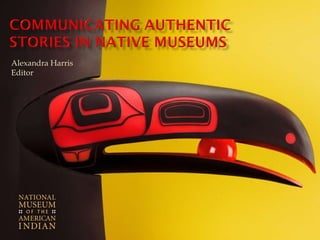Talking about the Tough Stuff at Native Museums, A. Harris
- 2. History project/ 75 th Anniversary of the Barona Indian Reservation Tribal member oversight Positive focus, low guilt factor Empowering history, not ŌĆ£Indians as victimsŌĆØ
- 3. ╠²
- 4. ╠²
- 5. ŌĆ£ Everything we do is potentially controversialŌĆØ Challenges: We replace the American mythology with a version of history that people are uncomfortable with because it is unfamiliar We need to communicate to the general public, who may come to us with little prior knowledge or a great deal Linear vs. intuitive styles of presenting exhibitions (our visitors expect linear, donŌĆÖt always get metaphor)
- 6. NMAI visitors: DonŌĆÖt trust that what theyŌĆÖve learned prior is true Our research has shown that some visitors donŌĆÖt trust what the government (i.e. NMAI as a representative) tells them to be true about American Indians (ŌĆ£broken promisesŌĆØ) Want the objective truth Want the details Have a moral compass, with expectations of justice, fairness, and truth-telling Range of prior knowledge: Easy to assume that visitors know basic concepts, but weŌĆÖre finding that foundation is missing
- 7. ŌĆ£ We have visitors?ŌĆØ vs. ŌĆ£ TheyŌĆÖll learn what we want them to learn.ŌĆØ vs. ŌĆ£ What do they want to learn?ŌĆØ
- 8. ╠²
- 9. Andrew Pekarik and Barbara Mogel September 29, 2009
- 10. museum aims with visitor aims
- 11. Visitors tend to find the experiences they came looking for
- 12. * Indicates statistically significant difference 2008 and 2009 data combined
- 13. ╠²
- 14. ╠²
- 15. An experience they were not expecting An expected experience that was delivered
- 16. PEOPLE Attract OBJECT Attract IDEA Attract ŌĆ£ Look in the drawer to learn moreŌĆØ
- 17. ╠²
- 18. ╠²
- 19. Foxx family, Mashpee Wampanoag, 2008. From left: Anne, Mon├®t, Majai, Aisha, and Maurice. Courtesy Foxx family, photo by Kevin Cartwright
- 20. Our Lives: Identity
- 21. Sensitive to the complexities of tribal histories while aiming to be accurate and comprehensive Involving National Museum of African American History and Culture as partner Involving many writers to cover a variety of perspectives Overcoming fear, vulnerability, risk DoesnŌĆÖt shy away from the truth, but communicates in a way that is ŌĆ£calm,ŌĆØ fact-based, asking for consideration, engaging the public in a dialogue Comanche family, early 1900s. Courtesy of Sam DeVenney
- 22. New Exhibition, will replace Our Peoples installation in 2012/13 Challenges: Making ŌĆ£paperŌĆØ interesting Cognitive Dissonance: VisitorsŌĆÖ belief that treaties were universally bad for Indian people If we donŌĆÖt ŌĆ£flipŌĆØ them early to the idea that they represent tribal sovereignty, visitors wonŌĆÖt understand the rest of the exhibit
- 23. Indians as sophisticated prior to European arrival Pre-contact tribal agreements and political traditions Iconic people and American myths Washington, Jefferson, Jackson, Lincoln, etc. are American heroes How to address the humanness of these people? We must tell the story in their words and actions Understanding sovereignty & its basis in treaties Treaties: not gifts but rights retained The exhibition will address the relevance and use of treaties today
- 24. Visitors assume that part of the exhibit would promote getting rid of treaties Visitors may not trust the view of a federal institution with regard to treaties Future testing: using objects currently on display to convey a treaty concept
- 25. Example of Potential: Kiowa Pipe For some tribes, a pipe symbolized the telling of truth and the sealing of an agreement. Pipes played roles in treaty negotiations, symbolizing for Native people what a signature on paper symbolized for Euro-Americans.
- 26. ŌĆ£ In many indigenous conceptions, creation emerges from the groundŌĆ” through the log tunnel from blindness into sight, from being unseen to being visible. Such was the case with this projectŌĆ”. I knew that this was the moment for an advancement of truth and reconciliation.ŌĆØ ŌĆö Gabrielle Tayac (Piscataway, exhibition curator), from the introduction to IndiVisible


























